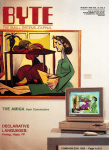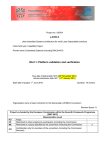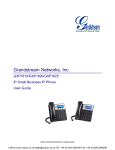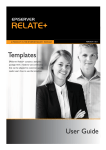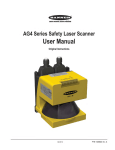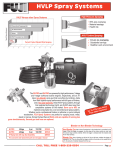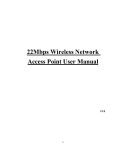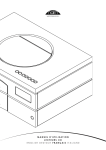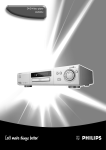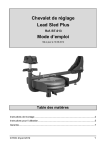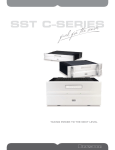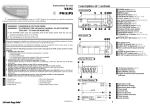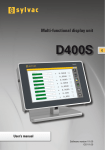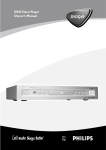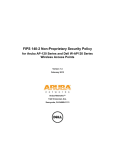Download User Manual
Transcript
ECB-1221R Wireless Long Range Multi-function Client Bridge User’s Manual Version: 1.1 ECB-1221R Wireless Long Range Multi-function Client Bridge Table of Contents 1 INTRODUCTION .................................................................................................................... 5 FEATURES & BENEFITS .................................................................................................................. 5 PACKAGE CONTENTS ..................................................................................................................... 7 UNIT DESCRIPTION ........................................................................................................................ 7 SYSTEM REQUIREMENTS................................................................................................................ 8 APPLICATIONS ............................................................................................................................... 8 NETWORK CONFIGURATION ............................................................................................................ 9 a) b) 2 Ad-hoc (peer-to-peer) Mode.................................................................................................... 9 Infrastructure Mode ............................................................................................................... 10 UNDERSTANDING THE HARDWARE .................................................................................11 HARDWARE INSTALLATION .............................................................................................................11 IP ADDRESS CONFIGURATION ........................................................................................................11 3 CLIENT BRIDGE/ROUTER & ROUTER/ AP ....................................................................... 13 BRIDGE/BRIDGE ROUTER TO ACCESS POINT ................................................................................. 13 ACCESS POINT TO BRIDGE/BRIDGE ROUTER ................................................................................. 13 4 ACCESS POINT/ROUTER MODE – CONFIG..................................................................... 14 LOGGING IN ................................................................................................................................. 14 MANAGEMENT ............................................................................................................................. 16 MANAGEMENT (ROUTER MODE).................................................................................................... 17 OPERATION MODE ....................................................................................................................... 17 STATUS ....................................................................................................................................... 19 STATISTICS .................................................................................................................................. 20 DYNAMIC DNS (ROUTER MODE)................................................................................................... 21 TIME ZONE SETTING (ROUTER MODE)........................................................................................... 22 DENIAL OF SERVICE (DOS) (ROUTER MODE) ................................................................................. 23 LOG ............................................................................................................................................ 23 UPGRADE FIRMWARE ................................................................................................................... 24 SAVE / RELOAD SETTINGS, RESET TO DEFAULT ............................................................................. 25 PASSWORD ................................................................................................................................. 26 TCP/IP SETTINGS ....................................................................................................................... 26 LAN INTERFACE .......................................................................................................................... 27 4.3.2 SNMP SETTINGS................................................................................................................ 27 WLAN INTERFACE (ROUTER MODE) ............................................................................................. 28 PPPOE....................................................................................................................................... 30 PPTP (POINT-TO-POINT TUNNELING PROTOCOL) (ROUTER MODE) ................................................ 31 WIRELESS ................................................................................................................................... 33 BASIC SETTINGS (INFRASTRUCTURE, ADHOC) ............................................................................... 34 ADVANCED SETTINGS .................................................................................................................. 35 SECURITY ................................................................................................................................... 36 ENCRYPTION DISABLED ............................................................................................................... 37 WEP 64-BIT / 128-BIT.................................................................................................................. 38 WPA / WPA2 PASSPHRASE.......................................................................................................... 39 WPA / WPA2 RADIUS AUTHENTICATION ..................................................................................... 40 WIRELESS DISTRIBUTION SYSTEM ................................................................................................ 40 FIREWALL .................................................................................................................................... 41 MAC ADDRESS FILTER ................................................................................................................ 43 PORT FORWARDING ..................................................................................................................... 43 WEB SITE FILTER ......................................................................................................................... 44 DMZ........................................................................................................................................... 45 2 ECB-1221R Wireless Long Range Multi-function Client Bridge 4 CLIENT BRIDGE/ROUTER MODE – CONFIG.................................................................... 46 LOGGING IN ................................................................................................................................. 46 MANAGEMENT ............................................................................................................................. 48 OPERATION MODE ....................................................................................................................... 49 STATUS ....................................................................................................................................... 50 STATISTICS .................................................................................................................................. 51 LOG ............................................................................................................................................ 51 UPGRADE FIRMWARE ................................................................................................................... 52 SAVE / RELOAD SETTINGS, RESET TO DEFAULT ............................................................................. 52 PASSWORD ................................................................................................................................. 53 TCP/IP SETTINGS ....................................................................................................................... 54 LAN INTERFACE .......................................................................................................................... 54 STATIC IP ADDRESS ..................................................................................................................... 55 DHCP CLIENT ............................................................................................................................. 55 DHCP SERVER ........................................................................................................................... 56 SNMP SETTINGS ........................................................................................................................ 57 CLIENT BRIDGE ROUTER .............................................................................................................. 58 WLAN INTERFACE ....................................................................................................................... 58 PPPOE....................................................................................................................................... 59 WIRELESS ................................................................................................................................... 61 BASIC SETTINGS .......................................................................................................................... 61 ADVANCED SETTINGS .................................................................................................................. 62 SECURITY ................................................................................................................................... 64 ENCRYPTION DISABLED ............................................................................................................... 64 WEP 64-BIT / 128-BIT.................................................................................................................. 65 WPA / WPA2 / WPA2 MIXED PASSPHRASE .................................................................................. 66 WIRELESS SITE SURVEY ......................................................................................................................... 67 APPENDIX A – FCC INTERFERENCE STATEMENT.................................................................. 68 APPENDIX B – IC STATEMENT................................................................................................... 69 3 ECB-1221R Wireless Long Range Multi-function Client Bridge Revision History Version Date Notes 1.0 1.1 March 21, 2008 March 22, 2008 Created Chapters added 4 ECB-1221R Wireless Long Range Multi-function Client Bridge 1 Introduction The Wire less Client Bri dge/AP/Router/Bridge Router devic e ope rates seamlessly in the 2.4 GH z fre quency spe ctrum s upporting the 802.11b (2.4GHz, 11Mbps) and faster 802 .11g (2.4GHz, 54Mbps) w ireless standards. It's the best w ay to add wireless ca pability t o your existing wired netwo rk, or to add b andwidth to your wireless installation. ECB-1220R has high transmitted output power and high receivable sensitivity. High output power and high sen sitivity can extend range and cov erage to redu ce the roaming b etween APs to ge t more stability w ireless c onnection. It also can re duce the expense of equipment in the same environment. To protect your wireless connectivity, it can encrypt all wireless transmissions through 64/128-bit WEP da ta e ncryption an d als o su pports WPA/WPA2. The MAC addres s filter lets you select exactly which stations should have access to your network. User isolation function can protect the private network between client users. This chapter describes the features & ben efits, package contents, applications, and network configuration. Features & Benefits Features Benefits Client Bridge/AP/Router/Client Router High Speed Data Rate Up to 54Mbps Capable of handling heavy data payloads such as MPEG video streaming High Output Power Solution Excellent output power spreads the operation distance IEEE 802.11b/g Compliant Fully Interoperable with IEEE 802.11b/IEEE802.11g compliant devices 5 ECB-1221R Wireless Long Range Multi-function Client Bridge SNMP Remote Configuration Help administrators to remotely Management configure or manage the Access Point easily. Point-to-point, Point-to-multipoint Let users transfer data between two Wireless Connectivity buildings or multiple buildings DoS (Denial of Service) protection Prevent from well-known DoS attack Built-in 4-port Switch automatically detects cable type Web-based configuration Easy local connectivity Firmware change via the Web-based configuration screen System log Allow easy upgrade/restore/dump system configuration via web interface Logging critical event according to network manager’s criteria Simple and intuitive network management WPA2/WPA/ IEEE 802.1x support Powerful data security DHCP Client/ Server Simplifies network administration Universal Repeater The easiest way to expand your wireless network's coverage Keep personal setting Keep the latest setting when firmware upgrade Router/AP Mode NAT Router UPnP(Universal Plug and Play) Port forwarding Access control Firewall Hide SSID Multiple computer Internet Access, also act as natural firewall Friendly to special application e.g. instant messenger, VoIP Set up application server (FTP, Web, Email, …) on LAN WLAN-to-WAN access control (allow/disallow), prevent users from access unwanted content Prevent malicious access from Internet Avoids unallowable users sharing bandwidth, increases efficiency of the network WDS (Wireless Distributed System) Make wireless AP and Bridge mode simultaneously as a wireless repeater MAC address filtering Ensures secure network connection 6 ECB-1221R Wireless Long Range Multi-function Client Bridge User isolation support Protect the private network between client users. Client Router mode PPPoE function support Easy to access internet via ISP service authentication Package Contents Open the package carefully, and make sure t hat none o f the ite ms listed below are missing. Do n ot dis card the packing materials, in ca se o f return; the unit mus t b e shipped in its original package. h One Wireless Client Bridge Unit h One Switching Power Adapter (12V/ 1.25A) h One CAT5 UTP Cable h One CD-ROM with User’s Manual Unit Description Omni Directional Antenna Router/AP/Client Bridge/Client Router 7 ECB-1221R Wireless Long Range Multi-function Client Bridge System Requirements The f ollowing are t he minim um s ystem requirements i n order c onfigure the device. h PC/AT compatible computer with Ethernet interface. h Operating system that supports HTTP web-browser Applications The wireless LAN p roducts are easy to install and highly efficient. The following list describes some of the many ap plications ma de possible through the p ower an d flexibility of wireless LANs: a) Difficult-to-wire environments There are many s ituations w here wires cannot be laid e asily. Historic buildings, older buildings, o pen are as and ac ross b usy s treets make the installation of LANs either impossible or very expensive. b) Temporary workgroups Consider situations in parks, athletic arenas, exhibition centers, disasterrecovery, temporary offices and construction si tes where on e wants a temporary WLAN established and removed. c) The ability to access real-time information Doctors/nurses, poin t-of-sale e mployees, a nd wa rehouse w orkers can access rea l-time informa tion while d ealing w ith patients, se rving customers and processing information. d) Frequently changed environments Show rooms, meeting rooms, retail stores, and manufacturing sites where frequently rearrange the workplace. e) Small Office and Home Office (SOHO) networks SOHO users need a cost-effective, easy and quick installation of a small 8 ECB-1221R Wireless Long Range Multi-function Client Bridge network. f) Wireless extensions to Ethernet networks Network managers in dynamic environments c an minimize the overhead caused by moves, ex tensions t o ne tworks, and o ther c hanges with wireless LANs. g) Wired LAN backup Network manage rs implement wireless LANs to provide backup for mission-critical applications running on wired networks. h) Training/Educational facilities Training sites a t co rporations and s tudents a t univ ersities use wireless connectivity to eas e acc ess t o in formation, information ex changes, a nd learning. Network Configuration To better u nderstand h ow the wireless LAN p roducts work toge ther to create a wireless network, it might be helpful to depict a few of the possible wireless LAN PC card network configurations. The wireless LAN products can be configured as: a) Ad-hoc (or peer-to-peer) for departmental or SOHO LANs. b) I nfrastructure for enterprise LANs. a) Ad-hoc (peer-to-peer) Mode This is t he simples t network c onfiguration with s everal c omputers equipped with the PC Cards that form a wireless network whenever they are within range of one another. In ad-hoc mode, each client is peer-topeer, wo uld only hav e access to the res ources o f the o ther client an d does not require an access point. This is the e asiest and least expensive way for the SOHO to set up a wireless network. The image below depicts a network in ad-hoc mode. 9 ECB-1221R Wireless Long Range Multi-function Client Bridge b) Infrastructure Mode The infrastructure mode requires the use of an access point (AP). In this mode, all wireless commun ication between two c omputers has to be via the AP. It doesn’t matter if the AP is stand-alone or wired to an Ethernet network. If use d in stand-alone, the AP can extend the range of independent w ireless L ANs b y a cting as a repeater, which effec tively doubles the distance between wireless stations. The image below depicts a network in infrastructure mode. 10 ECB-1221R Wireless Long Range Multi-function Client Bridge 2 Understanding the Hardware Hardware Installation 1 Place the unit in an appropriate place after conducting a site survey. 2 Plug one end of the Ethernet cable into the RJ-45 port of the device and another end into your PC/Notebook. 3 Insert the D C-inlet o f the pow er ad apter in to the port labeled “DC -IN” and the other end into the power socket on the wall. This diagram depicts the hardware configuration PC Ethernet Bridge/AP AC/DC cable Power Outlet IP Address Configuration This dev ice c an be con figured as a Client Bridge or Access Poin t. The de fault IP address of the device is 192.168.1.1 or 192.168.1.2. In order to log into this dev ice, you must first configure the TCP/IP settings of your PC/Notebook. 1. In the control panel, double click Network Connections and then double click on the connection of your Net work Int erface C ard (NIC). You will then see the following screen. 11 ECB-1221R Wireless Long Range Multi-function Client Bridge 2. Selec t Internet Protocol (TCP/IP) and then click on the Properties button. This will allow you to configure the TCP/IP settings of your PC/Notebook. 3. Selec t Use the following IP Address radio button and then enter the IP address and subnet mask. Ensure that the IP address and subnet mask are on the same subnet as the device. For Example: Device IP address: 192.168.1.1 PC IP address: 192.168.1.10 PC subnet mask: 255.255.255.0 4. C lick on the OK button to c lose this w indow, a nd o nce again to clos e LAN properties window. 12 ECB-1221R Wireless Long Range Multi-function Client Bridge 3 Client Bridge/Router & Router/ AP This device can be configured as a Bridge or Access Point. The default IP address of the d evice is 192.168.1.1 in Client Bridge /Client Router mode. The default IP address of the device is 192.168.1.2 in AP/Router mode. This chapter will describe the steps to switch from Bridge to Access Point and Access Point to Bridge. Bridge/Bridge Router to Access Point 1 Enter the default IP address (192.168.1.2) of the bridge into the address bar of the web-browser. 2 By de fault, a user name and pas sword ha s not been c onfigured. If you hav e configured a u ser na me a nd pa ssword, please en ter them into the field to continue 3 Once you ha ve logge d in, click on the Operation Mode lin k un der the Management menu. 4 Since this d evice is cu rrently in Bri dge mode, the Bridge radio but ton will be selected by default. 5 Se lect the AP radio button to and then click on the Apply Change to switch the operation mode to Access Point. 6 Wait for ab out 1 minute an d the d evice will auto matically re start into Acc ess Point mode. Access Point to Bridge/Bridge Router 1 Enter the default IP address (192.168.1.1) of the bridge into the address bar of the web-browser. 2 By de fault, a user name and pas sword ha s not been c onfigured. If you hav e configured a u ser na me a nd pa ssword, please en ter them into the field to continue 3 Once you ha ve logge d in, click on the Operation Mode lin k un der the Management menu. 13 ECB-1221R Wireless Long Range Multi-function Client Bridge 4 Since this d evice is currently in Access Point mode, the AP radio butt on will be selected by default. 5 Se lect the Bridge or Bridge Router radio button to and then click on the Apply Change to switch the operation mode to Bridge. 6 Wait for about 1 minu te and t he dev ice will auto matically restart into Bridge mode. 4 Access Point/Router Mode – Config Logging In To configure the AP through the web-browser, type IP address (default: 192.168.1.2) into the address bar of the web-browser and press Enter. Make sure that the ECB-1221R and your computers are on the same subnet. Refer to Chapter 2 in order to configure the IP address of your computer. Username:admin; Password:admin 14 ECB-1221R Wireless Long Range Multi-function Client Bridge After logging in you will graphical user interface (GUI) of the bridge. The navigation drop-down menu on left is divided into three main sections: 1. Management: This includes operation m ode, st atus, statistics, logs, u pgrade firmware, save/reload settings, and password. 2. TCP/IP Settings: This incl udes the con figuration of the L AN port an d s ettings for the LAN IP, subnet mask, DHCP client, spanning tree and MAC cloning. 3. Wireless: This includes the b asic, adva nced, s ecurity an d sit e-survey settings for the wireless interface. The B ridge status page is a lso d isplayed o nce you have l ogged i n. This includes details about the system, wireless, and TCP/IP configuration. System o Uptime: Duration of time since the device was last reset. o Firmware version: V ersion of the firmwar e t hat i s currently loaded o n th e device. Wireless Configuration: 15 ECB-1221R Wireless Long Range Multi-function Client Bridge o Mode: Wireless configuration mode such as Client Bridge, AP, or WDS. o Band: Frequency and IEEE 802.11 operation mode (b-only, g-only, or b+g). o SSID: The name used to identify the wireless network. o Channel Number: The cha nnel us ed t o communicate o n the wirel ess network. o Encryption: The ty pe o f secur ity used on this net work. It ma y b e disabled, WEP, WPA, etc. o BSSID: The MAC address of the SSID. o State: The current s tate of the br idge. It ma y be scanni ng or ass ociated o r disabled. o Signal Strength: The signal strength of the wireless device. o Noise Level: The level of interference. TCP/IP Configuration: o Attain IP Protocol: The IP address setting may be fixed or static. o IP Address: Displays the current IP address of the LAN port. o Subnet Mask: Displays the current subnet mask for the IP address. o Default Gateway: Displays the default gateway for the device. o DHCP: Displays the DHCP setting. o MAC Address: Displays the MAC address of the device. Management Click on t he Management lin k on the na vigation drop-down menu . You will t hen see fi ve options: operation mo de, sta tus, sta tistics, l og, u pgrade firmware, s ave/reload sett ings, a nd password. Each option is described below. 16 ECB-1221R Wireless Long Range Multi-function Client Bridge Management (Router mode) Operation Mode Click on the Operation Mode li nk und er the Management menu. The Operation Mode allows you to switch from Client Bridge to Access Point mode/Router Mode. 17 ECB-1221R Wireless Long Range Multi-function Client Bridge Select the AP, Bridge or Bridge Router and then click on the Apply Change button. Please wait and the n enter the spec ified IP address into the web- browser. The previous settings will be retained in AP mode. . Refer to Chapter 5 to learn how to configure this device in Access Point mode. 18 ECB-1221R Wireless Long Range Multi-function Client Bridge Status Click on the Status link under the Management menu. The Status page is the first page that is displayed o nce y ou have lo gged i n. This in cludes d etails about the system, wireless, and TCP/IP configuration. 19 ECB-1221R Wireless Long Range Multi-function Client Bridge System o Uptime: Duration of time since the device was last reset. o Firmware version: V ersion of the firmwar e t hat i s currently loaded o n th e device. Wireless Configuration: o Mode: Wireless configuration mode such as Client Bridge, AP, or WDS. o Band: Frequency and IEEE 802.11 operation mode (b-only, g-only, or b+g). o SSID: The name used to identify the wireless network. o Channel Number: The channe l us ed t o communicate o n the wirel ess network. o Encryption: The ty pe o f secur ity used on this ne twork. It ma y b e disabled, WEP, WPA, etc. o BSSID: The MAC address of the SSID. o State: The current s tate of the br idge. It ma y be scanni ng or ass ociated o r disabled. o Signal Strength: The signal strength of the wireless device. o Noise Level: The level of interference. TCP/IP Configuration: o Attain IP Protocol: The IP address setting may be fixed or static. o IP Address: Displays the current IP address of the LAN port. o Subnet Mask: Displays the current subnet mask for the IP address. o Default Gateway: Displays the default gateway for the device. o DHCP: Displays the DHCP setting. o MAC Address: Displays the MAC address of the device. Statistics Click on the Statistics l ink u nder the Management menu. This pa ge display s the number of sent and received packets on the Ethernet and Wireless interface. 20 ECB-1221R Wireless Long Range Multi-function Client Bridge Additional WAN traffic information under Router Mode Since the packet counter is not dynamic, you must click on the Refresh button for the most recent statistics. Dynamic DNS (Router mode) Allows you to host a ser ver (W eb, FTP , Game Se rver, etc. ) using a domain name that you h ave p urchased with your dynamically assigned IP a ddress. Most broadband In ternet Se rvice Pr oviders a ssign d ynamic ( changing) IP a ddresses. When y ou use a Dy namic DNS service prov ider, y our f riends can enter y our h ost name to connect to your server, no matter what your IP address is. • Enable Dynamic DNS: Place a check in this box to enable the DDNS feature. • Service Address: S elect a DD NS service provide r from the d rop-down list. DynDNS is a free service while TZO offers a 30 day free trial. • Host Name: Specify the website URL. • User Name: Specify the user name for the DDNS service. • Password: Specify the password for the DDNS service and verify it once again in the next field. 21 ECB-1221R Wireless Long Range Multi-function Client Bridge • Timeout: Specify the t ime between periodic updates to the Dynamic DNS, if the dynamic IP address has not changed. The timeout period is entered in hours. • Cli ck on the Save Settings button once you have modified the settings. Time Zone Setting (Router mode) Click on the Time link in the navig ation menu. This feature allows you to configure, update, and maintain the correct time on the device’s internal system clock as well as configure the time zone. The date and time of the device can be configured manually or by synchronizing with a time server. Note: If the device losses power for any reason, it wi ll not be able to keep its clock running, an d w ill no t display the correct time on ce t he device has be en r estarted. Therefore, you must re-enter the correct date and time. 22 ECB-1221R Wireless Long Range Multi-function Client Bridge Current Time: Displays the current time on the device. Time Zone: Select your time zone from the drop-down list. Enable NTP Server: Place a check in this box if you would like to synchronize the device’s clock to a Network Time Server over the Internet. If you are using schedules or logs, this is the best way to ensure that the schedules and logs are kept accurate. NTP Server Used: Specify the NTP server or select one from the drop-down list. Click on the Apply Change button once you have modified the settings. Denial of Service (DoS) (Router mode) DoS attack is a n a ttempt by ha ckers to b lock services for le gitimate use rs of a PC/Network. Check the kind of specific protection you need. Log C lick on the Log link under the Management menu. The Log page displays a list of events that are t riggered on th e E thernet an d Wireless inte rface. This l og can be 23 ECB-1221R Wireless Long Range Multi-function Client Bridge referred when an unknown error occurs on the system or when a report needs to be sent to the technical support department for debugging purposes. In order for the log to record all the events, you must first place a check in the Enable Log or Enable Remote Log (Log Server required) check box. Se lect system all or wireless depending on the type of events you want recorded. Since the log i s not d ynamic, y ou must c lick o n the Refresh butt on for the most recent events, or click on the Clear button to clear the log. Upgrade Firmware Click on the Upgrade Firmware li nk un der th e Management m enu. Th is p age is used to up grade the f irmware o n the d evice. Make sure tha t d ownloaded the appropriate firmware from your vendor. 24 ECB-1221R Wireless Long Range Multi-function Client Bridge Click on the Browse button and then select the appropriate firmware and then clic k on the Upload button. Clic k on Reset to Default to restore the device to factory default settings. Note: The upgrade process may take abo ut 1 minute to com plete. Do no t power off the device during this process as it may crash the devic e and make it unusable. The device will restart automatically once the upgrade is complete. Save / Reload Settings, Reset to Default Click on the Save / Reload Setting link under the Management menu. This option is used to save t he c urrent s ettings of the d evice in a f ile on your local dis k o r load settings on t o the dev ice f rom a local disk. This feature is very handy for administrators who have sever al devi ces that need to be configu red with the sam e settings. This page also allows you to reset the device to its factory default settings. 25 ECB-1221R Wireless Long Range Multi-function Client Bridge Click on the Save button to save the current settings to a file on the local disk. Click on t he Browse bu tton t o s elect the s ettings file a nd the n click on the Upload button to load the previously saved settings. Click on the Reset b utton to reset the device to it s f actory default settings. Cli ck Restart to reboot the device. Password Click on the Password link under the Management menu. This option allows you to create a user name and password for the device. By default, this device is configured without a user name and password. For security reasons it is hig hly recommended that you create a user name and password. En ter a user name into the first field. Enter a password into the New Password field and then re-type the password into the Confirmed Password field. Then click on the Apply Changes button. By clicking on the Reset button, the user name and pa ssword fields w ill be come blank indicating that the username and password has been disabled. TCP/IP Settings C lick on the TCP/IP Settings li nk on the navigation drop-down menu. Y ou w ill then see the LA N Interface a nd SNM P o ption. The options are described in detail below. 26 ECB-1221R Wireless Long Range Multi-function Client Bridge LAN Interface Click on the LAN Interface link under the TCP/IP Settings menu. Using this option you may change the IP address of the device as well as toggle the DHCP setting. IP Address: Enter the IP address. Subnet Mask: Enter the subnet mask for the IP address. Default Gateway: Enter the IP address for the default gateway. DHCP: If this device is a DHCP client and w ill receive its IP s ettings fro m a DHCP server, t hen sele ct Enabled fro m t he dro p-down li st. E nabling the DH CP client will disable the IP address, subnet mask, and default gateway fields. If the DHCP option is disabled, the n the IP a ddress, subnet mask, and default gateway fields must be filled in. Click on t he Apply Changes b utton t o c onfirm t he changes. This d evice will automatically restart once these changes have been applied. 4.3.2 SNMP Settings SNMP Daemon: Select Enable if you would like to use the SNMP feature. 27 ECB-1221R Wireless Long Range Multi-function Client Bridge Read-Only Community Name: Specify the p assword f or access the S NMP community for read only access. Read-Write Community Name: Specify the passw ord f or access t o the S NMP community with read/write access. Send SNMP Trap: Select Enable if you would like to receive SNMP traps. Send Trap To: Specify the IP address that would receive the SNMP traps. Trap Community Name: Specify the password for the SNMP trap community. Click on the Save Settings button once you have modified the settings. WLAN Interface (Router mode) DHCP Connection (Dynamic IP address) – Choose this connection type if your ISP provides you the IP address. Most cable modems use this type of connection. PPPoE (Point-to-Point Protocol over Ethernet) – Ch oose this o ption if your internet connection requires a user name and password. Most DSL modems use this type of connection. Static IP address – Choose this option if you have a dedicated IP address. DHCP Client WAN in terface c an b e configured as a DH CP Client in w hich the ISP p rovides the IP address to the device. This is also known as Dynamic IP. Se lect the DHCP and click on the Apply Changes button. You have the option of cloning your PCs MAC address onto the device. Click on the Clone Your PCs MAC Address to automatically copy the MAC address. You may also specify a host name 28 ECB-1221R Wireless Long Range Multi-function Client Bridge (Router mode) Static IP Static IP is a fixed IP configuration whe re a ll p arameters includi ng DN S if a ny shoul d explicitly configured. VPN pass through is configured here by defining exclusivity. 29 ECB-1221R Wireless Long Range Multi-function Client Bridge (Router mode) PPPoE This ty pe o f conn ection is usually use d for a DS L s ervice and req uires a username an d password to connect. 30 ECB-1221R Wireless Long Range Multi-function Client Bridge (Router mode) Username / Password & Connection type (PPPoE) sho uld be in put then click on the Connect button. Address Mode: P PPoE c an be u sed w ith a d ynamic or sta tic IP ad dress. If y ou select the Dynamic IP r adio b utton, then the IIP address in t he next field is not required. However, if you select the Static IP radio button, then the IP address in the next field is required. User Name: Specify the user name which is provided by your ISP. Password: Specify the passw ord which is provided by your IS P, and then verify it once again in the next field. PPTP (Point-to-Point Tunneling Protocol) (Router mode) The WAN inter face ca n b e configured as P PTP. PP TP ( Point to Point Tunneling Protocol) us es a virtual private network to connect to y our ISP. This me thod of connection is primarily u sed in E urope. Th is me thod of connect ion req uires you to 31 ECB-1221R Wireless Long Range Multi-function Client Bridge enter a username and password (provided by your ISP) to gain access to the Internet. The supported authentication protocols are PAP and CHAP. S elect the Username / Password Connection (PPTP) ra dio b utton and the n click on the Next button. Address Mode: PPTP can be used with a dynamic or static IP address. If you select the Dynamic IP r adio b utton, then t he IIP a ddress in the n ext field is n ot requi red. However, if you select the Static IP radio button, then the IP address in the next field is required. PPTP Address: Specify the IP address PPTP Subnet Mask: Specify the subnet mask for the IP address. PPTP Server IP Address: If the PP TP Server’s IP address is different from the default gateway, then you may specify it here. User Name: Specify the user name which is provided by your ISP. Password: Specify the passw ord which is provided by your IS P, and then verify it once again in the next field. 32 ECB-1221R Wireless Long Range Multi-function Client Bridge Wireless Click on the Wireless link on the navigation drop-down menu. You will then see four options: b asic sett ings, a dvanced settin gs secur ity and s ite survey. E ach option is described below. 33 ECB-1221R Wireless Long Range Multi-function Client Bridge Basic Settings (Infrastructure, Adhoc) Click on the Basic Settings lin k und er t he Wireless men u. Using this o ption you may configure the 802.11b/g settings as well as the frequency, channel, and SSID. Band: Depending on the type of wireless clients that are connected to the network, you m ay select B, G, or B+G. If y ou ar e not s ure about w hich c lients will be accessing the wireless networks, it is recommended that you select B+G for the best performance. SSID: The S SID is a un ique nam ed s hared amongst a ll t he points of the wirel ess network. The SSID must be identical on all points of the wireless network and cannot exceed 32 characters. Channel: Sel ect a c hannel from the dr op-down list. T he c hannels av ailable are based on the country’s regulation. When selecting Infrastructure mode, a channel is not r equired, h owever, whe n s electing A dhoc mo de, you mu st select the same channel on all points. Enable Universal Repeater Mode: Select Enable to activ ate U niversal R epeater Mode and type below SSID for extended wireless interface. 34 ECB-1221R Wireless Long Range Multi-function Client Bridge Advanced Settings Click on t he Advanced Settings link unde r t he Wireless me nu. On th is p age yo u can configure t he advanced s ettings t o tw eak th e performance of y our wireless network. Options availa ble a re: frag mentation th reshold, RTS thr eshold, beacon interval, data rate, preamble type, and 802.11g protection. Authentication Type: select an authentication method. Options a vailable are Open System, Shared Key or Auto. An open system allows any client to authenticate as long a s it conforms to a ny MAC ad dress filter poli cies that may have b een s et. All authentication packets are transmitted w ithout encry ption. S hared Key sends an unencrypted challenge text string to any device attempting to communicate with the AP. The de vice r equesting auth entication encry pts the c hallenge tex t an d sen ds it back to the access point. If the challenge text is encrypted correctly, the access point allows the requesting device to authenticate. It is rec ommended to select Auto if you are not sure which authentication type is used. Fragment Threshold: Packets over the s pecified size will be fragmented in order to improve performance on noisy networks. 35 ECB-1221R Wireless Long Range Multi-function Client Bridge RTS Threshold: Packets over the specified size will use the RTS/CTS mechanism to maintain pe rformance i n n oisy ne tworks and preve nting hidden no des fro m degrading the performance. Beacon Interval: Beacons will be sent out to devices at the specified intervals. This value is measured in milliseconds (ms). ACK Timeout: You may specify a value for the acknowledge timeout. Data Rate: Select a data rate from the drop-down list. However, it is recommended to select auto for the best performance. Preamble Type: For b est pe rformance, all de vices on the w ireless netw ork s hould use t he same p reamble ty pe. Howeve r, the wirel ess ne twork will still functio n even though the wrong preamble type is used. Enable/Disable: A few options to enable some Wireless settings. Click on t he Apply Changes b utton t o c onfirm t he changes. This d evice will automatically restart once these changes have been applied. Security Clic k on the Security link under the Wireless menu. On this page you can configure the authentication and encryption settings such as WEP, WPA, and 80.1x. 36 ECB-1221R Wireless Long Range Multi-function Client Bridge Encryption Disabled Encryption: Select None from the drop-down list if your wireless network does not use any type of encryption. Click on t he Apply Changes b utton t o c onfirm t he changes. This d evice will automatically restart once these changes have been applied. 37 ECB-1221R Wireless Long Range Multi-function Client Bridge WEP 64-bit / 128-bit Encryption: Select WEP from the drop-down list if your wireless network uses WEP encryption. WE P is an ac ronym for Wired Equivalent P rivacy, and is a security protocol that provides the same level of security for wireless networks as for a wired network. Set WEP Key: Click on this button to configure the WEP Key. 38 ECB-1221R Wireless Long Range Multi-function Client Bridge Key Length: Select a 64-bit or 128-bit from the drop-down list. Key Format: Select a key format from the drop-down list. 64bit-hex keys require 10 characters, where as 128- bit keys require 26 characters. A hex key is def ined as a number between 0 through 9 and letter between A through F. Default Tx Key: You ma y u se up to four d ifferent keys for f our different n etworks. Select the current key that will be used. Encryption Key 1-4: You may enter four different WEP keys. Click on t he Apply Changes button to con firm th e c hanges an d t hen clic k on the Close button to return to the pervious window. WPA / WPA2 Passphrase Encryption: Select WPA or WPA2 from the drop-down list if your wireless network uses this encryption. WPA (Wi-Fi Protected Access) was designed to improve upon the security features of WEP (Wired Equivalent Privacy). The technology is designed to wo rk with e xisting Wi- Fi products that h ave be en e nabled with WEP . WPA provides imp roved data enc ryption through the Te mporal Integ rity P rotocol (TK IP), which scrambles the keys u sing a has hing algorithm and by a dding an integrity checking feature which makes sure that keys haven’t been tampered with. 39 ECB-1221R Wireless Long Range Multi-function Client Bridge WPA Authentication Mode: Select the Personal (Pre-Shared Key) radio button. WPA/WPA2: Select TKIP or AES as the cipher suite. Pre-Shared Key Format: Select Passphrase from the drop-down list. Pre-Shared Key: E nter the pass phrase here; this should be b etween 8 and 6 3 characters. Click on t he Apply Changes b utton t o c onfirm t he changes. This d evice will automatically restart once these changes have been applied. WPA / WPA2 RADIUS Authentication Encryption: Select WPA or WPA2 from the drop-down list if your wireless network uses this encryption. WPA (Wi-Fi Protected Access) was designed to improve upon the security features of WEP (Wired Equivalent Privacy). The technology is designed to wo rk with e xisting Wi- Fi products that h ave be en e nabled with WEP . WPA provides imp roved data enc ryption through the Te mporal Integ rity P rotocol (TK IP), which scrambles the keys using a has hing algorithm and by a dding an integrity checking feature which makes sure that keys haven’t been tampered with. WPA Authentication Mode: Select the Enterprise (RADIUS) radio button. WPA/WPA2: Select TKIP or AES as the cipher suite. RADIUS Port: Enter the port number o f the RADIUS server . The default is usually 1812. RADIUS IP Address: Enter the IP address of the RADIUS server. RADIUS Password: Enter the shared password of the RADIUS server. Click on t he Apply Changes b utton t o c onfirm t he changes. This d evice will automatically restart once these changes have been applied. Wireless Distribution System • Wireless Distribution Sy stem u ses wire less med ia to commun icate with other A Ps, like the Ethernet does. To do this, you must set these APs in the same channel and set MAC address of other APs which you want to commu nicate with in the table and then enable the WDS. 40 ECB-1221R Wireless Long Range Multi-function Client Bridge Enable WDS - choose to enable/disable Adding WDS AP: Enter MAC address. Set Security – WEP/WPA/WPA2-mixed Show Statistics – shows details of WDS AP Apply settings – click to save settings. Firewall The d evice p rovides a tight f irewall by vi rtue of the w ay NAT w orks. U nless you configure t he route r to the c ontrary, the NA T doe s n ot r espond to unsolicited incoming requests on any port, thereby making your LAN invisible to Internet cyber attacks. However, some n etwork applications cannot run with a tight firewall. Th ose applications need to sele ctively op en ports in the firewall to fu nction co rrectly. The options on t his pa ge c ontrol sev eral wa ys of opening t he f irewall to add ress the needs of specific types of applications. 41 ECB-1221R Wireless Long Range Multi-function Client Bridge The Ac cess Con trol sec tion allows you t o con trol access in a nd ou t o f d evices on your network. Use this feature as Parental Controls to only grant access to approved sites, limit web access based on time or dates, and/or block access from applications such as peer-to-peer utilities or games. When Access Control is disabled, every device on the LAN has unrestricted access to the Internet. However, if you enable Access Control, Internet access is restricted for those de vices that h ave an Access Control Policy configured for them. All other devices have unrestricted access to the Internet. 42 ECB-1221R Wireless Long Range Multi-function Client Bridge MAC Address Filter This feature is used to restrict certain MAC address from a ccessing the Internet. These filters can be used for securing and restricting your network. Configure MAC Filtering: Select one of the options from the drop-down list. o Turn MAC Filtering OFF: When "OFF" is selected, MAC addresses are not used to control network access. o Turn MAC Filtering ON and ALLOW computers listed to access the network: When "ALLOW" is s elected, only computers with MAC addresses listed in the MAC Filtering Rules list are granted network access. o Turn MAC Filtering ON and DENY computers listed to access the network: When "DENY" is selected, any computer with a MAC address listed in the MAC Filtering Rules list is refused access to the network. MAC Address: Specify that MAC address that you would like to filter. Clic k Apply Changes button to store the changes. Port Forwarding Multiple connect ions a re required by some appli cations, such a s internet games, video confe rencing, Intern et teleph ony, an d othe rs. These a pplications ha ve difficulties working through NAT (Network Address Translation). This section is used to o pen mult iple p orts o r a ran ge of ports in y our route r a nd redirect d ata throu gh those ports to a single PC on your network. 43 ECB-1221R Wireless Long Range Multi-function Client Bridge Enable: Place a check in this box to enable the port forwarding rule. Name: Assign a me aningful n ame to t he virtual s erver, f or example Web S erver. Several well- known ty pes of virtual ser ver are avai lable fro m t he A pplication Name drop-down list. Selecting one of these entries fills some of the remaining parameters with standard values for that type of server. IP Address: Specify the IP address for the virtual server entry. TCP/UDP Ports: Specify the TCP or UDP port numbers. Web site Filter This is a type of parental control feature used to restrict certain websites form being accessed through your network. These filters can be used for securing and restricting your network. Website/URL/Domain: Specify the web address that you would like to filter. Do n ot use “http://” Click on the Apply changes button to store the changes. 44 ECB-1221R Wireless Long Range Multi-function Client Bridge DMZ Place check in this box to enable DMZ host. DMZ host is a demilitarized zone used to provide Internet services without sacrificing unauthorized access to its local private network. Typically, the DMZ host contains devices accessible to Internet traffic, such as web, FTP, email and DNS servers. DMZ IP Address: Specify the IP address of the DMZ host. Click on the Apply changes button to store the changes. 45 ECB-1221R Wireless Long Range Multi-function Client Bridge 4 Client Bridge/Router Mode – Config Logging In To configure the Access Point through the web-browser, enter the IP address of the Bridge (d efault: 192.168.1.1) i nto t he address ba r of the w eb-browser a nd press Enter. Make sure that the Access Point and your computers are on the same subnet. Refer to Chapter 2 in order to configure the IP address of your computer. Log in User name:admin; Password:admin After logg ing in you will g raphical user interface (GUI ) of the Access Point. The navigation drop-down menu on left is divided into three main sections: 4. Management: This includes operation m ode, st atus, statistics, logs, u pgrade firmware, save/reload settings, and password. 5. TCP/IP Settings: This incl udes the con figuration of the L AN port an d s ettings for the LAN IP, subnet mask, DHCP client, spanning tree and MAC cloning. 6. Wireless: This includes the b asic, adva nced, s ecurity an d sit e-survey settings for the wireless interface. The A ccess P oint status p age is also displayed once you h ave logg ed in . This includes details about the system, wireless, and TCP/IP configuration. 46 ECB-1221R Wireless Long Range Multi-function Client Bridge 47 ECB-1221R Wireless Long Range Multi-function Client Bridge o System o Uptime: Duration of time since the device was last reset. o Firmware version: V ersion of the firmwar e t hat i s currently loaded o n th e device. Wireless Configuration: o Mode: Wireless configuration mode such as client bridge, AP, or WDS. o Band: Frequency and IEEE 802.11 operation mode (b-only, g-only, or b+g). o SSID: The name used to identify the wireless network. o Channel Number: The channe l us ed t o communicate o n the wirel ess network. o Encryption: The ty pe o f secur ity used on this ne twork. It ma y b e disabled, WEP, WPA, etc. o BSSID: The MAC address of the SSID. o Associated Clients: D isplays the numb er of c lients currently ass ociated to the Access Point. TCP/IP Configuration: o Attain IP Protocol: The IP address setting may be fixed or static. o IP Address: Displays the current IP address of the LAN port. o Subnet Mask: Displays the current subnet mask for the IP address. o Default Gateway: Displays the default gateway for the device. o DHCP: Displays the DHCP setting. o MAC Address: Displays the MAC address of the device. Management Click on t he Management lin k on the na vigation drop-down menu . You will t hen see fi ve options: operation mo de, sta tus, sta tistics, l og, u pgrade firmware, s ave/reload sett ings, a nd password. Each option is described below. 48 ECB-1221R Wireless Long Range Multi-function Client Bridge Operation Mode Click on the Operation Mode li nk und er the Management menu. The Operation Mode allows you to switch from Access Point to Client Bridge mode. Se lect the AP, Bridge or Bridge Router and then click on the Apply Change button. Wait for about a minute until you see the Pop-Up message. Click on the OK button and then enter the specified IP address into the web-browser. Please wait and the n enter the spec ified IP address into the web- browser. The previous settings will be retained in AP mode. . 49 ECB-1221R Wireless Long Range Multi-function Client Bridge Refer to Chapter 4 t o learn h ow t o configure this devic e in B ridge/Bridge Ro uter mode. Status Click on the Status link under the Management menu. The Status page is the first page that is displayed o nce y ou have lo gged i n. This in cludes d etails about the system, wireless, and TCP/IP configuration. System o Uptime: Duration of time since the device was last reset. o Firmware version: V ersion of the firmwar e t hat i s currently loaded o n th e device. Wireless Configuration: o Mode: Wireless configuration mode such as client bridge, AP, or WDS. o Band: Frequency and IEEE 802.11 operation mode (b-only, g-only, or b+g). o SSID: The name used to identify the wireless network. o Channel Number: The channe l us ed t o communicate o n the wirel ess network. o Encryption: The ty pe o f secur ity used on this net work. It may b e disabled, WEP, WPA, etc. o BSSID: The MAC address of the SSID. o Associated Clients: D isplays the numb er of c lients currently ass ociated to the Access Point. TCP/IP Configuration: o Attain IP Protocol: The IP address setting may be fixed or static. o IP Address: Displays the current IP address of the LAN port. o Subnet Mask: Displays the current subnet mask for the IP address. o Default Gateway: Displays the default gateway for the device. o DHCP: Displays the DHCP setting. o MAC Address: Displays the MAC address of the device. 50 ECB-1221R Wireless Long Range Multi-function Client Bridge Statistics Click on the Statistics l ink u nder the Management menu. This pa ge display s the number of sent and received packets on the Ethernet and Wireless interface. Since the packet counter is not dynamic, you must click on the Refresh button for the most recent statistics. Log C lick on the Log link under the Management menu. The Log page displays a list of events that are t riggered on th e E thernet an d Wireless inte rface. This lo g can be referred when an unknown error occurs on the system or when a report needs to be sent to the technical support department for debugging purposes. In order for the log to record all the events, you must first place a check in the Enable Log or Enable Remote Log (Log Server required) check box. Se lect system all or wireless depending on the type of events you want recorded. 51 ECB-1221R Wireless Long Range Multi-function Client Bridge Since the log i s not d ynamic, y ou must c lick o n the Refresh butt on for the most recent events, or click on the Clear button to clear the log. Upgrade Firmware Click on the Upgrade Firmware li nk un der th e Management m enu. Th is p age is used to up grade the f irmware o n the d evice. Make sure tha t d ownloaded the appropriate firmware from your vendor. Click on the Browse button and then select the appropriate firmware and then clic k on the Upload button. Note: The upgrade process may take about 1 minute to complete. Do n ot power off the device during this process as it may crash the devic e and make it unusable. The device will restart automatically once the upgrade is complete. Save / Reload Settings, Reset to Default Click on the Save / Reload Setting link under the Management menu. This option is used to save t he c urrent s ettings of the d evice in a f ile on your local dis k o r load settings on t o the dev ice f rom a local disk. This feature is very handy for administrators who have sever al devi ces that need to be configu red with the sam e settings. This page also allows you to reset the device to its factory default settings. 52 ECB-1221R Wireless Long Range Multi-function Client Bridge Click on the Save button to save the current settings to a file on the local disk. Click on t he Browse b utton to s elect the s ettings file and the n cli ck on the U pload button to load the previously saved settings. Click on the Reset b utton to reset the device to it s f actory default settings. Cli ck Restart to reboot the device. Password Click on the Password link under the Management menu. This option allows you to create a user name and password for the device. By default, this device is configured without a user name and password. For security reasons it is highly recommended that you create a user name and password. 53 ECB-1221R Wireless Long Range Multi-function Client Bridge En ter a user name into the first field. Enter a password into the New Password field and then re-type the password into the Confirmed Password field. Then click on the Apply Changes button. By clicking on the Reset button, the user name and pa ssword fields w ill become blank indicating that the username and password has been disabled. TCP/IP Settings Clic k on the TCP/IP Settings lin k on the navigation drop-down m enu. You will then see t he LA N Interface a nd S NMP option. The options are described in detail below. LAN Interface Click on the LAN Interface link under the TCP/IP Settings menu. Using this option you may cha nge the IP add ress o f the device as well as toggle the DH CP server/client and 802.1d spanning tree feature. 54 ECB-1221R Wireless Long Range Multi-function Client Bridge Static IP Address IP Address: Enter the IP address. Subnet Mask: Enter the subnet mask for the IP address. Default Gateway: Enter the IP address for the default gateway. DHCP: Since a static IP address is used, this option must be set to Disabled. If this device is a DHCP c lient a nd will receive its IP settings from a D HCP server, then select Enabled from the drop-down list. Enabling the DHCP client will disable the IP address, subn et mask, an d default gateway fields. If the DHCP o ption is Disabled, then the IP address, subnet mask, and default gateway fields must be filled in. Click on t he Apply Changes b utton t o c onfirm t he changes. This d evice will automatically restart once these changes have been applied. DHCP Client 55 ECB-1221R Wireless Long Range Multi-function Client Bridge DHCP: If this device is a DHCP client and w ill receive its IP s ettings fro m a DHCP server, the n select Client from the dro p-down lis t. Enabling the DH CP client will disable the IP address, subnet mask, and default gateway fields. If the DHCP option is disabled, the n the IP a ddress, subnet mask, and default gateway fields must be filled in. Click on t he Apply Changes b utton t o c onfirm t he changes. This d evice will automatically restart once these changes have been applied. DHCP Server 56 ECB-1221R Wireless Long Range Multi-function Client Bridge IP Address: Enter the IP address. Subnet Mask: Enter the subnet mask for the IP address. Default Gateway: Enter the IP address for the default gateway. DHCP: Select Server from the drop-down list since this d evice is the DHCP server. This device will distribute the IP addresses to the clients associated. DHCP Client Range: Enter the first and last IP address of the range. Make sure that the r ange is on th e sam e s ubnet a s the d evice. You may clic k on the S how Cl ient button to view a list of IP addresses that were distributed. Click on t he Apply Changes b utton t o c onfirm t he changes. This d evice will automatically restart once these changes have been applied. SNMP Settings SNMP Daemon: Select Enable if you would like to use the SNMP feature. Read-Only Community Name: Specify the p assword f or access the S NMP community for read only access. Read-Write Community Name: Specify the passw ord f or access t o the S NMP community with read/write access. Send SNMP Trap: Select Enable if you would like to receive SNMP traps. Send Trap To: Specify the IP address that would receive the SNMP traps. Click on the Save Settings button once you have modified the settings. 57 ECB-1221R Wireless Long Range Multi-function Client Bridge Client Bridge Router WLAN Interface DHCP Connection (Dynamic IP address) – Choose this connection type if your ISP provides you the IP address. Most cable modems use this type of connection. PPPoE (Point-to-Point Protocol over Ethernet) – Ch oose this o ption if your internet connection requires a user name and password. Most DSL modems use this type of connection. Static IP address – Choose this option if you have a dedicated IP address. DHCP Client WAN interface can be configured as a DHCP Client in which the ISP provides the IP address to the device. This is also known as Dynamic IP. Se lect the DHCP and click on the Apply Changes button. You have the option of cloning your PCs MAC address onto the device. Click on the Clone Your PCs MAC Address to automatically copy the MAC address. You may also specify a host name 58 ECB-1221R Wireless Long Range Multi-function Client Bridge Static IP Static IP is a fixed IP configuration whe re a ll p arameters includi ng DN S if a ny shoul d explicitly configured. VPN pass through is configured here by defining exclusivity. PPPoE This ty pe o f conn ection is usually use d for a DS L s ervice and req uires a username an d password to connect. 59 ECB-1221R Wireless Long Range Multi-function Client Bridge Username / Password & Connection type (PPPoE) sho uld be in put then click on the Connect button. Address Mode: P PPoE c an be u sed w ith a d ynamic or sta tic IP ad dress. If y ou select the Dynamic IP r adio b utton, then the IIP address in t he next field is not required. However, if you select the Static IP radio button, then the IP address in the next field is required. User Name: Specify the user name which is provided by your ISP. Password: Specify the passw ord which is provided by your IS P, and then verify it once again in the next field. 60 ECB-1221R Wireless Long Range Multi-function Client Bridge Wireless Click on the Wireless link on the navigation drop-down menu. You will then see five options: basic settings, advanced s ettings security, a ccess control and WDS . Each option is described below. Basic Settings Click on the Basic Settings lin k und er t he Wireless men u. Using this o ption you may configure the 802.11b/g settings as well as the frequency, channel, and SSID. 61 ECB-1221R Wireless Long Range Multi-function Client Bridge Band: Select the IEEE 802.11 mode from the dr op-down list. Options available are 2.4GHz (B), 2.4GHz (G), or 2.4GHz (B+G). Select the appropriate mode based on the type of wireless network. For example, if you are sure that the wireless network will be using only IEEE 802.11g clients, then it is recommended to select 2.4GHz (G) instead of 2.4GHz (B+G) which will reduce the performance of the wireless network. SSID: The S SID is a un ique nam ed s hared amongst a ll t he points of the wirel ess network. The SSID must be identical on all points of the wireless network and cannot exceed 32 characters. Channel: Sel ect a c hannel from the dr op-down list. T he c hannels av ailable are based on the country’s regulation. When selecting Infrastructure mode, a channel is not r equired, h owever, whe n s electing A dhoc mo de, you mu st select the same channel on all points. Show Active Clients: Click on this button to view a list of associated clients. Click on t he Apply Changes b utton t o c onfirm t he changes. This d evice will automatically restart once these changes have been applied. Enable Universal Repeater Mode: Select Enable to activ ate U niversal R epeater Mode and type below SSID for extended wireless interface. Advanced Settings Click on t he Advanced Settings link unde r t he Wireless me nu. On th is p age yo u can configure t he advanced s ettings t o tw eak th e performance of y our wireless network. Options availa ble a re: frag mentation th reshold, RTS thr eshold, b eacon interval, output power, preamble type, broadcast SSID, IAPP, and 802.11g protection. 62 ECB-1221R Wireless Long Range Multi-function Client Bridge Authentication Type: select an authentication method. Options a vailable are Open System, Shared Key or Auto. An open system allows any client to authenticate as long a s it conforms to a ny MAC ad dress filter poli cies that may have b een s et. All authentication packets are transmitted w ithout encry ption. S hared Key sends an unencrypted challenge text string to any device attempting to communicate with the AP. The de vice r equesting auth entication encry pts the c hallenge tex t an d sen ds it back to the access point. If the challenge text is encrypted correctly, the access point allows the requesting device to authenticate. It is rec ommended to select Auto if you are not sure which authentication type is used. Fragment Threshold: Packets over the s pecified size will be fragmented in order to improve performance on noisy networks. RTS Threshold: Packets over the specified size will use the RTS/CTS mechanism to maintain pe rformance i n n oisy ne tworks and preve nting hidden no des fro m degrading the performance. Beacon Interval: Beacons will be sent out to devices at the specified intervals. This value is measured in milliseconds (ms). ACK Timeout: You may specify a value for the acknowledge timeout. 63 ECB-1221R Wireless Long Range Multi-function Client Bridge Data Rate: Select a data rate from the drop-down list. However, it is recommended to select auto for the best performance. Data Rate: If you would like to force a data rate, you may sel ect one from the dropdown list. However, for best performance it is recommended to use the Auto setting. Preamble Type: For b est pe rformance, all de vices on the w ireless netw ork s hould use t he same p reamble ty pe. Howeve r, the wirel ess ne twork will still functio n even though the wrong preamble type is used. Transparent Bridge: Can be Enabled/Disabled Click on t he Apply Changes b utton t o c onfirm t he changes. This d evice will automatically restart once these changes have been applied. Security Clic k on the Security link under the Wireless menu. On this page you can configure the authentication and encryption settings such as WEP, WPA, and 802.1x. Encryption Disabled Encryption: Select None from the drop-down list if your wireless network does not use any type of encryption. Click on t he Apply Changes b utton t o c onfirm t he changes. This d evice will automatically restart once these changes have been applied. 64 ECB-1221R Wireless Long Range Multi-function Client Bridge WEP 64-bit / 128-bit Encryption: Select WEP from the drop-down list if your wireless network uses WEP encryption. WE P is an ac ronym for Wired Equivalent P rivacy, and is a security protocol that provides the same level of security for wireless networks as for a wired network. Set WEP Key: Click on this button to configure the WEP Key. Key Length: Select a 64-bit or 128-bit from the drop-down list. Key Format: Select a key format from the drop-down list. 64bit-hex keys require 10 characters, where as 128- bit keys require 26 characters. A hex key is def ined as a number between 0 through 9 and letter between A through F. Default Tx Key: You ma y u se up to four d ifferent keys for f our different n etworks. Select the current key that will be used. Encryption Key 1-4: You may enter four different WEP keys. 65 ECB-1221R Wireless Long Range Multi-function Client Bridge Click on t he Apply Changes button to con firm th e c hanges an d t hen clic k on the Close button to return to the pervious window. WPA / WPA2 / WPA2 Mixed Passphrase Encryption: S elect WPA, WPA2 or WPA2_Mixed from the drop-down l ist if your wireless network uses this encryption. WPA (Wi-Fi P rotected Access) was d esigned to im prove up on the s ecurity fea tures of WEP (Wi red Equivalent P rivacy). The technology is d esigned to work with existing Wi-Fi products that have been enabled with WEP . WPA pro vides imp roved data e ncryption throu gh t he Te mporal Integrity Protocol (TKIP), which scrambles the keys using a hashing algorithm and by adding an integrity checking feature which makes sure that keys haven’t been tampered with. WPA Authentication Mode: Select the Personal (Pre-Shared Key) radio button. WPA/WPA2: Select TKIP, AES or both as the cipher suite. Pre-Shared Key Format: Select Passphrase from the drop-down list. Pre-Shared Key: Enter the pass phrase; this should be between 8 and 63 characters. Click on t he Apply Changes b utton t o c onfirm t he changes. Th is d evice will automatically restart once these changes have been applied. 66 ECB-1221R Wireless Long Range Multi-function Client Bridge Wireless Site Survey Clic k Refresh to see the WLAN AP’s that was de tected with modest details of each of them listed. 67 ECB-1221R Wireless Long Range Multi-function Client Bridge Appendix A – FCC Interference Statement Federal Communication Commission Interference Statement This e quipment has b een teste d an d fou nd to comply w ith the limit s for a Class B digital de vice, pursuant to P art 15 of the FCC Rules. T hese li mits a re designed to provide reaso nable prote ction against harmf ul interferenc e in a resid ential inst allation. This equ ipment generates uses an d ca n radiate radio frequenc y energ y and, if not installed a nd used in accordance with the instruction s, may cause harmful interference to radio communications. Ho wever, there is no guarantee that interference will not occur in a particular installation. If this eq uipment does cause harmful interference to radio or television reception, w hich can b e d etermined by turning the equipment o ff and on, the user is encouraged to try to correct the interference by one of the following measures: z z z z Reorient or relocate the receiving antenna. Increase the separation between the equipment and receiver. Connect the equip ment into a n ou tlet on a circ uit dif ferent fro m tha t to wh ich the rece iver is connected. Consult the dealer or an experienced radio/TV technician for help. FCC Cau tion: An y ch anges o r modifica tions not expressly a pproved b y the party r esponsible for compliance could void the user's authority to operate this equipment. This device complies with Part 15 of the FCC Rules. Operation is subject to the following two conditions: (1) This d evice may n ot cause h armful interference, and (2) this d evice mu st a ccept a ny in terference received, including interference that may cause undesired operation. IMPORTANT NOTE: FCC Radiation Exposure Statement: This e quipment comp lies with F CC radiation ex posure lim its s et fo rth f or an un controlled environment. This device complies with FCC RF Exposur e limits set forth for an unco ntrolled environment, under 47 CFR 2.1093 paragraph (d)(2). This transmitter must not be co-located or operating in conjunction with any other antenna or transmitter. 68 ECB-1221R Wireless Long Range Multi-function Client Bridge Appendix B – IC Statement IC statement Operation is subject to the following two conditions: This device may not cause interference and This device must accept any interference, including interference that may cause undesired operation of the device. This device has be en designed to operate with an antenna having a maximum gain of 9 dBi. Antenna having a high er ga in is strictly pro hibited per re gulations of Industr y C anada. T he requ ired a ntenna impedance is 50 ohms. IMPORTANT NOTE: IC Radiation Exposure Statement: This equipment complies with IC radiation exposure limits set forth for an uncontrolled environment. End users must fo llow th e sp ecific o perating in structions fo r sa tisfying RF exposure complia nce. This equipment should be inst alled and operated with minimum distance 20cm between the radiator & y our body. This transmitter must not be co-located or operating in conjunction with any other antenna or transmitter. Règlement d’Industry Canada Les conditions de fonctionnement sont sujettes à deux conditions: Ce périphérique ne doit pas causer d’interférence et. Ce périphérique doit acc epter toute interférence, y compris les interférenc es pouvant perturber le bon fonctionnement de ce périphérique. 69






































































